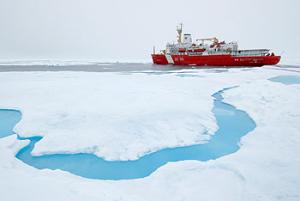Please note: You are viewing
the unstyled version of this website. Either your browser does not support CSS
(cascading style sheets) or it has been disabled. Skip
navigation.
DescriptionAt 392.5 feet in length, 80 feet in beam, and over 15,000 tons deadweight, the CCGS Louis S. St-Laurent is the queen of the Canadian ice breaking fleet. She is homeported in St. John's, Newfoundland, since being reassigned in 2009 from Dartmouth, Nova Scotia.MissionFor over thirty years, Louis S. St-Laurent has successfully served as an arctic research platform for the international scientific community. In addition to her scientific duties, Louis S. St-Laurent has also provided escort and resupply services to isolated settlements and commercial operations in the arctic.CrewA typical crew complement is 18 officers and 30 crew members. The crew is assigned to different departments, such as the operations department and the engineering department. The departments work together as a team to make sure the ship completes its missions efficiently and safely.Icebreaking capabilitiesAlthough Louis S. St-Laurent is capable of breaking very thick ice, rule number one in ice breaking is, “if possible, avoid the ice.” This is simply because it takes longer, consumes more fuel, and produces more wear and tear on the ship when battering through the ice. The most efficient way to break through ice is to find the weakest points in the ice, such as existing cracks or open areas called “leads.” When there are none, the ship will look for “first year ice”, which is often flat and 2-6 feet thick. As sea ice gets older it becomes considerably stronger, and changes color to a distinctive deep blue.ConstructionLouis S. St-Laurent was built in 1967 with a steam turbine propulsion plant. In 1989 she underwent a midlife refit, converting to a diesel electric system. Five huge diesel engines provide power for three shafts and propellers. The engines can produce 29,000 horsepower of power for breaking through the thick arctic ice.ScienceThe ship has 11 laboratory spaces and berthing space for up to 53 scientists. The oceanographic winches and lab spaces give scientists the flexibility to conduct a wide range of research activities.Last updated: October 2, 2015 | |||||||||||||||
Copyright ©2007 Woods Hole Oceanographic Institution, All Rights Reserved, Privacy Policy. | |||||||||||||||



